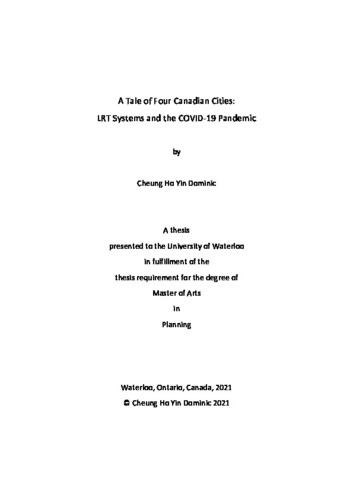| dc.contributor.author | Cheung, Ho Yin Dominic | |
| dc.date.accessioned | 2021-09-17 14:04:20 (GMT) | |
| dc.date.available | 2021-09-17 14:04:20 (GMT) | |
| dc.date.issued | 2021-09-17 | |
| dc.date.submitted | 2021-08-11 | |
| dc.identifier.uri | http://hdl.handle.net/10012/17407 | |
| dc.description.abstract | Light rail transit (LRT) systems have been proposed and implemented in many jurisdictions in Canada and abroad to cope with long-standing problems associated with urban sprawl. LRT systems are presented as an alternative mobility option to automobiles, a solution to alleviate traffic congestion, attract new property developments in existing urban areas close to downtown and enable higher density developments. However, there has been limited discussion and research on evaluating whether the LRT systems achieved their original policy goals and objectives. Thus, this research aims to address the performance of Canadian light rail transit (LRT) systems with respect to ridership and land development, and investigate the impact of the COVID-19 pandemic on meeting the original policy goals and objectives of LRT systems. Four LRT systems in Waterloo, Calgary, Vancouver and Ottawa were chosen as case studies to facilitate the research.
The research identified multiple Key Performance Indicators (KPIs) and created two scenarios to evaluate the LRT system performance and the impact of the pandemic on daily public transit commuting ridership. This research finds that the four case study LRT systems generally had satisfactory performance and mostly achieved their original policy and goals. During the peak of the pandemic, it is estimated that daily public transit commuting ridership decreased by over 40%, while the “new normal” scenario estimated a 20% drop in commuting trips as work from home policies become permanent in some workplaces. However, changes in ridership vary greatly among census tracts (CTs) as some CTs are estimated to experience much larger declines in ridership due to a concentration of industries which has higher potential for telework. While the COVID-19 pandemic is expected to impact the achievement of some policy goals and objectives of LRT systems, the extent of the impact is uncertain due to the ongoing changes of the pandemic. | en |
| dc.language.iso | en | en |
| dc.publisher | University of Waterloo | en |
| dc.subject | urban planning | en |
| dc.subject | covid-19 pandemic | en |
| dc.subject | light rail transit | en |
| dc.subject | urban development | en |
| dc.title | A Tale of Four Canadian Cities: LRT Systems and the COVID-19 Pandemic | en |
| dc.type | Master Thesis | en |
| dc.pending | false | |
| uws-etd.degree.department | School of Planning | en |
| uws-etd.degree.discipline | Planning | en |
| uws-etd.degree.grantor | University of Waterloo | en |
| uws-etd.degree | Master of Arts | en |
| uws-etd.embargo.terms | 0 | en |
| uws.contributor.advisor | Woudsma, Clarence | |
| uws.contributor.affiliation1 | Faculty of Environment | en |
| uws.published.city | Waterloo | en |
| uws.published.country | Canada | en |
| uws.published.province | Ontario | en |
| uws.typeOfResource | Text | en |
| uws.peerReviewStatus | Unreviewed | en |
| uws.scholarLevel | Graduate | en |

